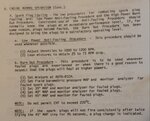I heard about this earlier -- I wasn't sure what kind of aircraft it was, but I had suspected it was a WWII aircraft: I was worried it was that guy who planned to fly a Spitfire around the world through several stops.
This is actually way worse.
This is actually way worse.

